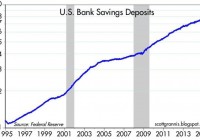Volatility Decays Without The Roll
“Roll Yield” is a frequently spoken about but lesser understood phenomenom. Volatility futures decay without the roll. Continue to short volatility for excellent long-run gains. Roll decay is a term that is commonly thrown around when discussing futures. It is an easily observable phenomenon in commodities markets that results from a positively sloping forward curve. When an electronically-traded-product “rolls” contracts along such a curve, it sells near-term futures and uses the proceeds to buy further-out futures. In rolling, the net value of the fund has not changed. Maybe 12 near-term contracts valued at $10 each were sold for 10 further-out $12 contracts. The gross value is $120 immediately before the transaction and $120 immediately after the transaction. There is no decay in asset value. The decay happens afterwards…sometimes. In the example above, both contracts were priced above the spot rate, and the further-out contract was priced above the near-term. If the underlying asset is a random walk, then on average (long-term average), the moving average of the spot will be equal to the current spot. In other words, the expected return on carry is 0. So both futures will need to drift down, and the further-out future will need to drift down more. In the real world, most assets are not a random walk. They tend to drift themselves. If they are positively correlated with the market, they tend to drift upwards; and vice versa. In commodities and equities markets, this drift is fairly deterministic in the long-run and becomes implicit in the term structure. Therefore the “roll” decay is, in fact, a result of rolling less-overpriced contracts into more-overpriced contracts. The VIX is very different. It’s not a random walk. It’s a random spring. It makes a lot of noise but its long-run moving average is very predictable. When the VIX spot is $12 and the first month future is $14, the empirically derived mathematical expectation of the first future isn’t to converge to $12. Instead it is to converge to something like $13, as the spot springs from $12 back toward its center and hits $13 along the way. Likewise when the VIX spot is $30 and the first month future is $26, a long position on the first month future still decays (on average) because the spot drops down to something like $25 on average. Please see this article for elaboration: The take away is that the slope of the volatility forward curve is of little to no consequence. ETN’s like TVIX, VXX, and VXZ will continue to decay so long as they are tied to VIX futures that are themselves individually overpriced (in comparison to their mathematical/statistical expectations.) For something like the VXX, the “roll” decay occurs because it is in constant possession of two futures contracts (M1 and M2), that are in an almost perpetual state of being over-priced. The allocations are irrelevant. If VXX stopped rolling contracts, any static mix of M1 and M2 would show similar performance on average. Volatility futures decay standing still. So unless you have a crystal ball or an uncanny ability to predict the future, betting against volatility futures continues to be highly advisable. There will be plenty of noise short-term, but long-term bets will reap in the green. And plea se see the following article if you would like to drown-out some of the noise: Disclosure: I/we have no positions in any stocks mentioned, and no plans to initiate any positions within the next 72 hours. (More…) I wrote this article myself, and it expresses my own opinions. I am not receiving compensation for it (other than from Seeking Alpha). I have no business relationship with any company whose stock is mentioned in this article. Additional disclosure: I am short volatility futures.
